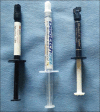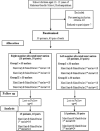Comparative Evaluation of Retention, Cariostatic Effect and Discoloration of Conventional and Hydrophilic Sealants - A Single Blinded Randomized Split Mouth Clinical Trial
- PMID: 30294150
- PMCID: PMC6169278
- DOI: 10.4103/ccd.ccd_132_18
Comparative Evaluation of Retention, Cariostatic Effect and Discoloration of Conventional and Hydrophilic Sealants - A Single Blinded Randomized Split Mouth Clinical Trial
Abstract
Introduction: Pit and fissures are approximately eight times vulnerable than the smooth surface caries lesion. Sealants are effective in preventing, arresting, and progression of pit-and-fissure occlusal caries lesions. The failure of sealant resin-based retention is mainly attributed to the moisture contamination. To overcome this drawback, UltraSeal XT® hydro, a moisture-friendly sealant, has been introduced.
Aim: This study aimed to compare and evaluate the retention, cariostatic effect, and discoloration of conventional Clinpro™ 3M™ ESPE™ and hydrophilic UltraSeal XT® sealants among 12 to 15-year-old schoolchildren for 3 months.
Materials and methods: A single-blinded, randomized, split-mouth clinical trial was conducted among thirty schoolchildren aged 12-15 years. Sealants used in the present study were Group I - Clinpro™ and Group II - UltraSeal XT® hydro. Sealants were provided in the school by two operators based on the computer-generated random sequence and the study participants were evaluated after 3 months for sealant coverage, caries incidence, and discoloration using Color, Coverage and Caries sealant evaluation system. Sealant coverage between the two sealants was compared using Mann-Whitney U-test and Z-test for proportions.
Results: A total of 47 teeth (78.3%) with UltraSeal XT® Hydro had the sealant covering in all the fissures compared to Clinpro™ 3M™ ESPE™ which was 46.7% (28 teeth) and the difference was observed to be statistically significant.
Conclusion: Hydrophilic UltraSeal XT® Hydro yielded better sealant coverage (retention) compared to the conventional Clinpro™ 3M™ ESPE™. No difference was observed with regard to cariostatic effect and discoloration.
Keywords: Clinpro™ 3M™ ESPE™; UltraSeal XT® hydro; retention; split-mouth trial.
Conflict of interest statement
There are no conflicts of interest.
Figures





Similar articles
-
Comparison and Evaluation of the Retention, Cariostatic Effect, and Discoloration of Conventional Clinpro 3M ESPE and Hydrophilic Ultraseal XT Hydro among 12-15-year-old Schoolchildren for a Period of 6 Months: A Single-blind Randomized Clinical Trial.Int J Clin Pediatr Dent. 2020 Nov-Dec;13(6):688-693. doi: 10.5005/jp-journals-10005-1859. Int J Clin Pediatr Dent. 2020. PMID: 33976497 Free PMC article.
-
Comparative evaluation of retention, marginal adaptation and marginal discoloration of hydrophilic and hydrophobic pit and fissure sealants: A split-mouth randomized controlled trial.Dent Med Probl. 2024 Jul-Aug;61(4):541-548. doi: 10.17219/dmp/149732. Dent Med Probl. 2024. PMID: 39121242 Clinical Trial.
-
Retention and remineralization effect of moisture tolerant resin-based sealant and glass ionomer sealant on non-cavitated pit and fissure caries: Randomized controlled clinical trial.J Dent. 2019 Jul;86:69-74. doi: 10.1016/j.jdent.2019.05.027. Epub 2019 May 25. J Dent. 2019. PMID: 31136817 Clinical Trial.
-
Comparative Evaluation of Penetration Ability of Three Pit and Fissure Sealants and Their Relationship with Fissure Patterns.J Dent (Shiraz). 2018 Jun;19(2):92-99. J Dent (Shiraz). 2018. PMID: 29854882 Free PMC article.
-
Comparative evaluation of retention and cariostatic effect of hydrophilic and hydrophobic resin-based sealants: A systematic review and meta-analysis.Niger J Clin Pract. 2022 Jun;25(6):861-884. doi: 10.4103/njcp.njcp_1863_21. Niger J Clin Pract. 2022. PMID: 35708429
Cited by
-
The effect of the Er: YAG laser on the clinical success of hydrophilic fissure sealant: a randomized clinical trial.Eur Oral Res. 2020 Sep 1;54(3):148-153. doi: 10.26650/eor.20200029. Eur Oral Res. 2020. PMID: 33543121 Free PMC article.
-
Retention Rate of Hydrophilic and Hydrophobic Resin-Based Sealant under Field Conditions: A Split-Mouth Randomized Controlled Clinical Trial.Eur J Dent. 2024 Jul;18(3):918-924. doi: 10.1055/s-0043-1777052. Epub 2024 Feb 22. Eur J Dent. 2024. PMID: 38387625 Free PMC article. Clinical Trial.
-
Comparison of the Success Rate of Filled and Unfilled Resin-Based Fissure Sealants: A Systematic Review and Meta-Analysis.Front Dent. 2022 Feb 8;19:10. doi: 10.18502/fid.v19i10.8855. eCollection 2022. Front Dent. 2022. PMID: 35937149 Free PMC article.
-
In Vitro Comparison of the Performance of Hydrophilic and Conventional Hydrophobic Resin-Based Fissure Sealants.Int Dent J. 2025 Aug;75(4):100824. doi: 10.1016/j.identj.2025.04.005. Epub 2025 May 17. Int Dent J. 2025. PMID: 40382913 Free PMC article.
-
Comparative Assessment of Compomers and Ormocers as Pit and Fissure Sealants in Permanent Molars among Children Aged 7-9 Years.Int J Clin Pediatr Dent. 2024 Jul;17(7):742-747. doi: 10.5005/jp-journals-10005-2954. Int J Clin Pediatr Dent. 2024. PMID: 39372526 Free PMC article.
References
-
- Young DA, Nový BB, Zeller GG, Hale R, Hart TC, Truelove EL, et al. The American dental association caries classification system for clinical practice: A report of the American Dental Association Council on Scientific Affairs. J Am Dent Assoc. 2015;146:79–86. - PubMed
-
- Morales E, Martínez A, Hernández J, Alvarado K, Pozos A. Evaluation of marginal seal and microleakage of a sealant modified with silver nanoparticles in primary molars:In vitro study. ODOVTOS Int J Dent Sci. 2014;16:107–13.
-
- Ripa LW, Leske GS, Sposato A. The surface-specific caries pattern of participants in a school-based fluoride mouthrinsing program with implications for the use of sealants. J Public Health Dent. 1985;45:90–4. - PubMed
-
- Wright JT, Crall JJ, Fontana M, Gillette EJ, Nový BB, Dhar V, et al. Evidence-based clinical practice guideline for the use of pit-and-fissure sealants: A report of the American Dental Association and the American Academy of Pediatric Dentistry. J Am Dent Assoc. 2016;147:672–82. - PubMed
-
- Simonsen RJ. Clinical Applications of the Acid Etch Technique. 1st ed. Chicago, IL: Quintessence Publishing Co., Inc.; 1978. Pit and fissure sealants; pp. 19–42.

